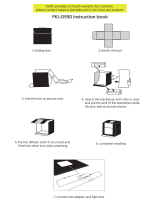
DVR-2
English Manual – Updated 2018-02-28 15
DVR-2
Introduction
DVR-2 offers Reverb and System 6000 users a
pristine Generic Reverb with true vintage flavor.
Generic Reverb is complementary to Source Re-
verb, and both types are at disposal in the 6000.
You can read more about Generic Reverb else-
where in this manual, but the term is used to de-
scribe a flattering sustain effect, which can be
added to many sources of a mix. It produces lit-
tle character but also does no harm, because the
effect is blurred or washed out. Instead, it adds
a good sense of spaciousness and more or less
pronounced modulation.
Recreation of a Classic
The development of DVR-2 has been a process
extending several years, with the goal of rec-
reating the most shining Generic Reverb of all
times, the EMT250. A particularly well sounding
machine was refurbished, and in the making of
DVR-2 many design disciplines were involved...
Hardware technical: What was the precision of
converters and how where they implemented in
the eighties with emphasis, block scaling, linear-
ity, filters etc? How much processing and RAM
was available, what was the sample rate etc?
Software technical: Which kind of processing
was done in discrete circuitry, what type of trun-
cation and noise floor artifacts would result, how
could the low sample rate be mimicked precise-
ly, and how could all of this be transferred to a
modern DSP platform.
Perceptual: Making sure the qualities of the origi-
nal processor was preserved. Sweet modulation,
spectral characteristics, spaciousness, distor-
tion, saturation etc. Hundreds of hours spent lis-
tening and measuring.
User: The four basic parameters of the EMT250
were carefully laid out, offering a remarkably
simple user interface with complex, yet opti-
mized interactions under the hood. DVR-2 is a
resemblance of that including range and coarse-
ness of parameters. Also the original I/O struc-
ture is kept with Mono in to Stereo and Quad out.
Better than the Classic?
While DVR-2 in Normal mode is very close to the
sound of a perfectly aligned 250, having used
much DSP power to mimic artifacts of old hard-
ware, the algorithm can also be put in a High
Resolution mode. Using this function, the noise-
floor is much lower, but use your own ears to
determine if this is actually a plus for a specific
situation.
Please note: Many of the constraints and criteria
listed above produce non-linear audio behavior,
making it impossible to obtain more than a static
and crude result if trying to sample an original
processor. A minute emulation does more justice
to the original from an audio point of view, and
can also still be adjusted.
The DVR-2 Source algorithm occupies:
►
@ Normal Sample Rate: 1/4 DSP Resource
►
@ Double Sample Rate: Currently not available
The inputs and outputs of this algorithm are dis-
tributed as follows:
Input Output
Mono
E1
E2
E3
E4
L
R
SL
SR
DVR-2 algorithm – main page
DVR-2 algorithm – main page






















